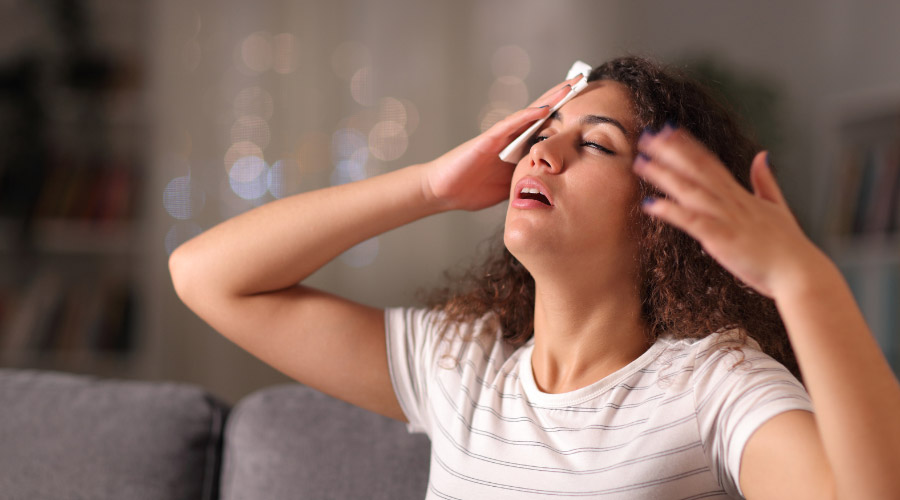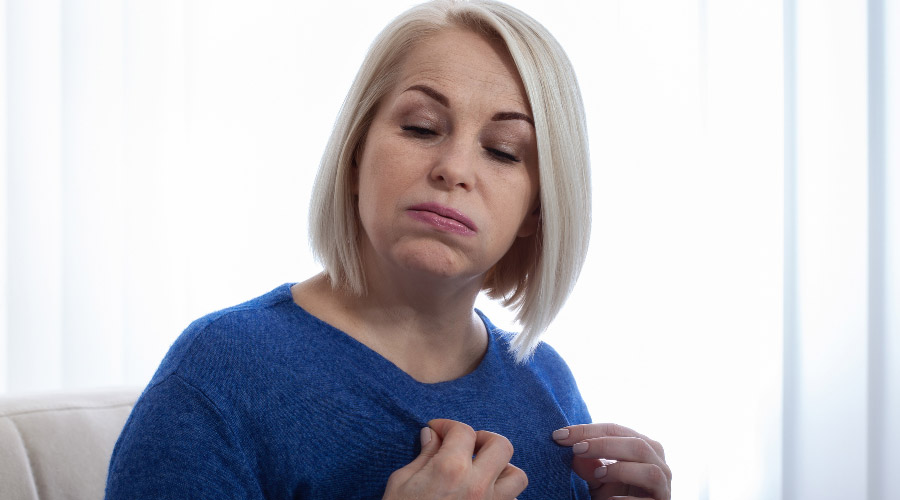Top tips for dealing with hot flushes and night sweats

If you are going through the perimenopause or menopause, there is a good chance you have experienced unpleasant hot flushes or night sweats.
Hot flushes and night sweats are the most common symptoms of the menopause (when periods stop) and they can have a significant effect on quality of life for many women.
They are believed to be caused by menopausal fluctuations in hormones, particularly in estrogen, that affect the area of the brain that controls temperature.
What is a hot flush?
Hot flushes involve a sudden feeling of heat that spreads through the body which can be accompanied by sweating, palpitations and a flushing of the face and neck. Night sweats are hot flushes that happen at night, leaving you exhausted from disturbed sleep and your night clothes and sheets drenched in sweat.
Hot flushes, which usually last a few minutes, start during the perimenopause (the period leading up to the menopause) and can continue for several years after the menopause.
While some women may experience none or only a couple of hot flushes a day, other women have many episodes. Either way, they can leave you feeling embarrassed, self-conscious and uncomfortable, and exacerbate other symptoms of the menopause such as low mood, fatigue and anxiety.
Dr Liz McCulloch, Hormone Health Associate, says: “For some women who I see it can affect every part of their life. It’s heart-breaking at times, especially when a woman feels she can no longer go into work or see her friends. I want those women to know that there is support out there, things which they can do that will alleviate these symptoms.”

So, if you suffer from hot flushes and night sweats, what can you do about them?
Here are our top tips for managing these symptoms effectively and minimising their impact on your day-to-day life:
1. Wear lightweight layers
Wear clothes made from natural materials such as cotton and in layers so that you can take a layer off when you feel too warm. Wearing tight-fitting clothes made of synthetic materials will prevent you from cooling down during a hot flush and may provoke a greater sense of panic as a result.
2. Stay cool at night
War night clothes made of natural fibres and sleep between cotton sheets. You could also try a cooling pillow. There are many of these on the market made of different materials that transfer heat away from the body.
3. Switch to decaf
If you drink a lot of coffee or tea, you may want to try non-caffeinated alternatives such as herbal teas as some research suggests caffeine can make hot flushes worse. Caffeine has a stimulant effect on the heart, increasing blood flow to the skin, which makes you sweat and feel flushed. Sipping a cool drink when you feel a hot flush coming on can help cool you down and remove that sense of panic.
4. Skip spicy foods
Chillies and hot peppers contain the heat-producing compound capsaicin which increases blood flow, gives you a sensation of heat when you eat them and may make hot flushes worse.
5. Try HRT
Hormone replacement therapy offers the most effective relief for hot flushes and night sweats. Combined HRT (taking estrogen and progestogen) is associated with an increased risk of breast cancer but this risk is extremely small (one extra case per 1,000 women per year) whereas your risk is higher if you are overweight, smoke or drink alcohol above the recommended levels.
In women without a womb (who have had a hysterectomy for example) who take estrogen-only HRT, there is no increased risk. Consult a health professional who will advise you on the best dose and method of HRT for you.
6. Cut back on alcohol
Alcohol, like caffeine and spicy food, dilates the blood vessels which increases blood flow and makes you sweat and feel flushed. Not all women are susceptible to this, but it may be worth cutting back on your alcohol intake to see if this helps and it will benefit your health generally.
7. Try herbal remedies
Some herbal remedies, although they are not as effective as HRT, can be helpful in treating menopause symptoms such as hot flushes and night sweats. Some research suggests that black cohosh can be helpful. It is not known exactly how it works although it may have an estrogen-type effect on the body so it should be avoided by women who have breast cancer or a history of the disease.
It may also affect your liver so do not take it if you suffer from liver problems. Use a good quality product and consult a health professional for advice.
8. Eat more soy
Foods such as soy, beans, lentils and pulses contain isoflavones which are estrogen-like plant compounds. Some studies show they may help to ease hot flushes and night sweats and some women who eat a diet rich in these foods, such as the Japanese diet, report fewer menopausal symptoms. If you wish to try a isoflavone supplement, it is a good idea to consult a health professional for advice.
9. Think yourself better
Cognitive behavioural therapy (CBT), a type of therapy which gives you strategies to change the way you think, may help women manage their hot flushes and night sweats, as well as improve sleep and lift mood. Some clinical trials have found that a course of CBT helps women address the negative thinking around these symptoms which in turn helps to alleviate them.
Women learn to feel calm and positive, rather than embarrassed and anxious, when experiencing a hot flush, for example.
10. Breathe easy
Breathing in a relaxed way is part of the CBT approach to hot flushes which can help you calm down and avoid the palpitations that some women experience. During a hot flush, try to focus on your breathing and breathe deeply in a relaxed way to feel calmer. Feeling less anxious and panicky will help make your symptoms seem more manageable